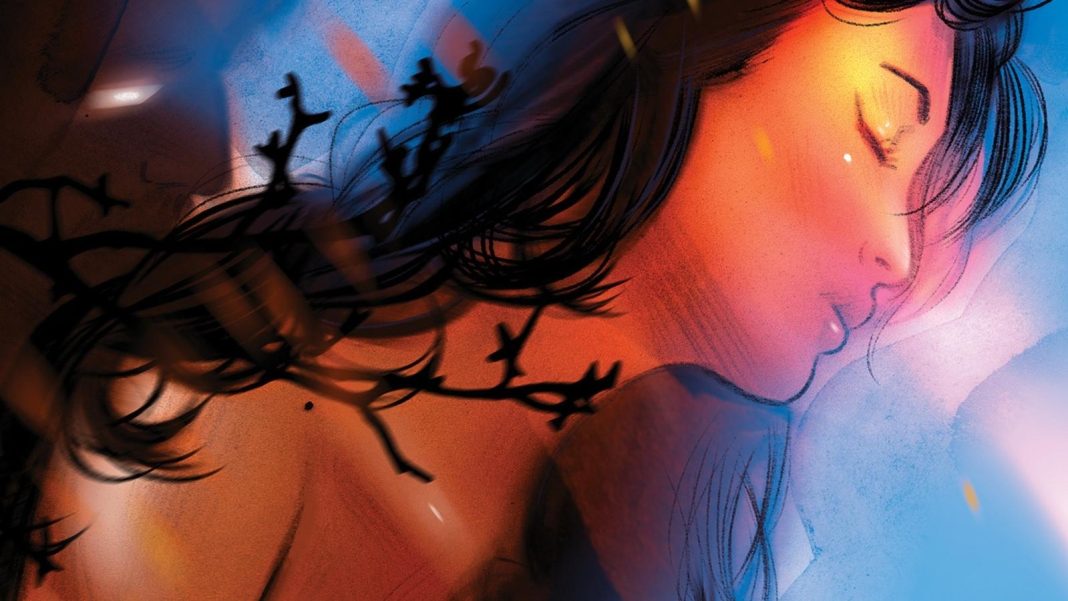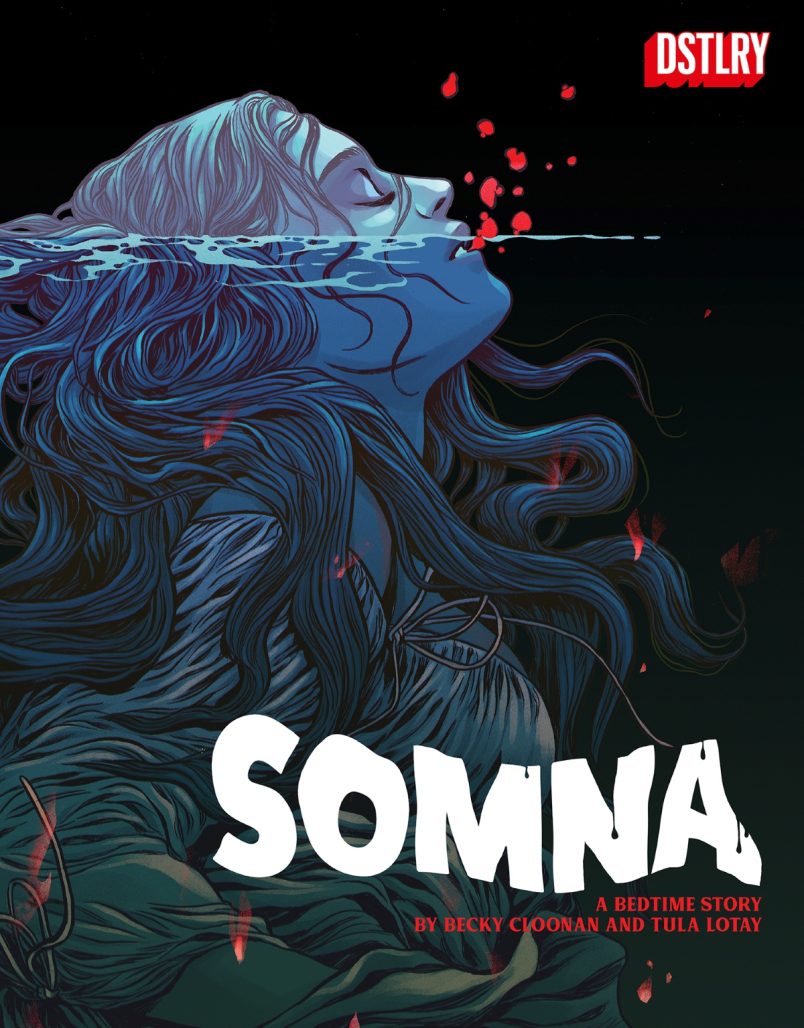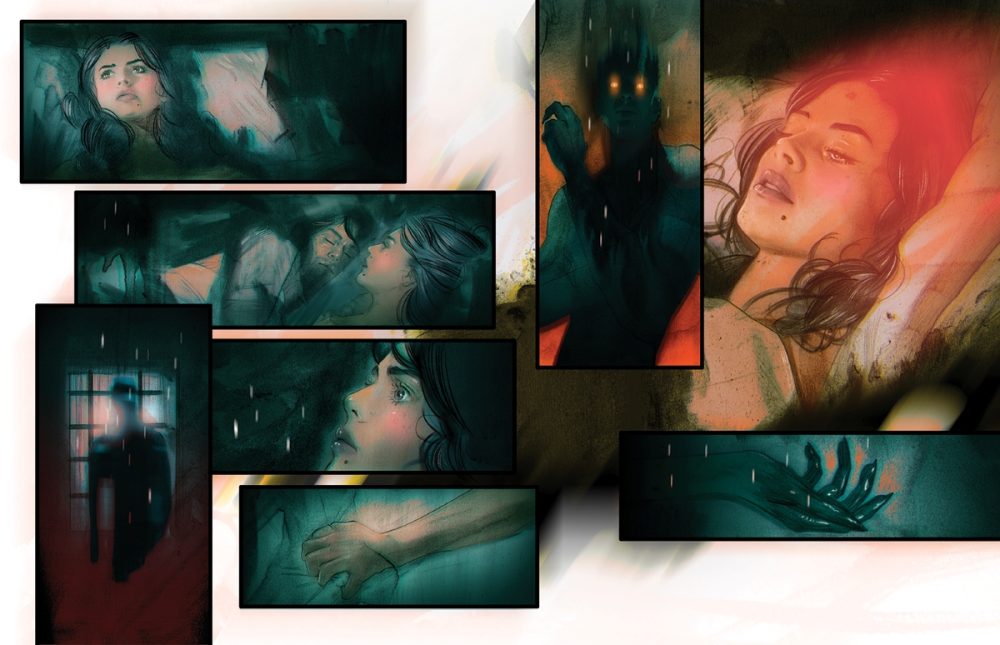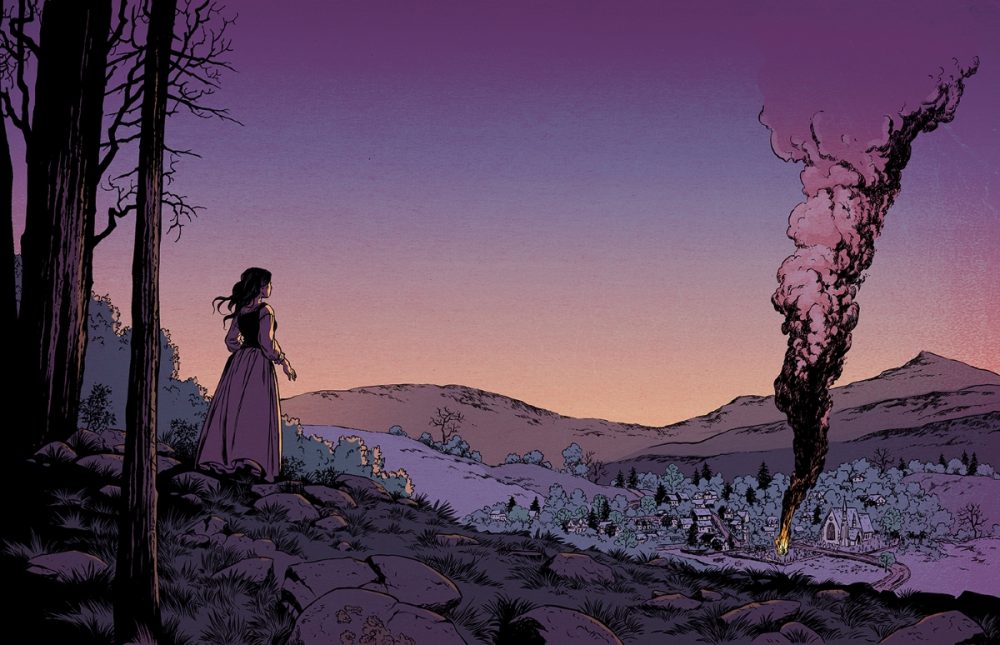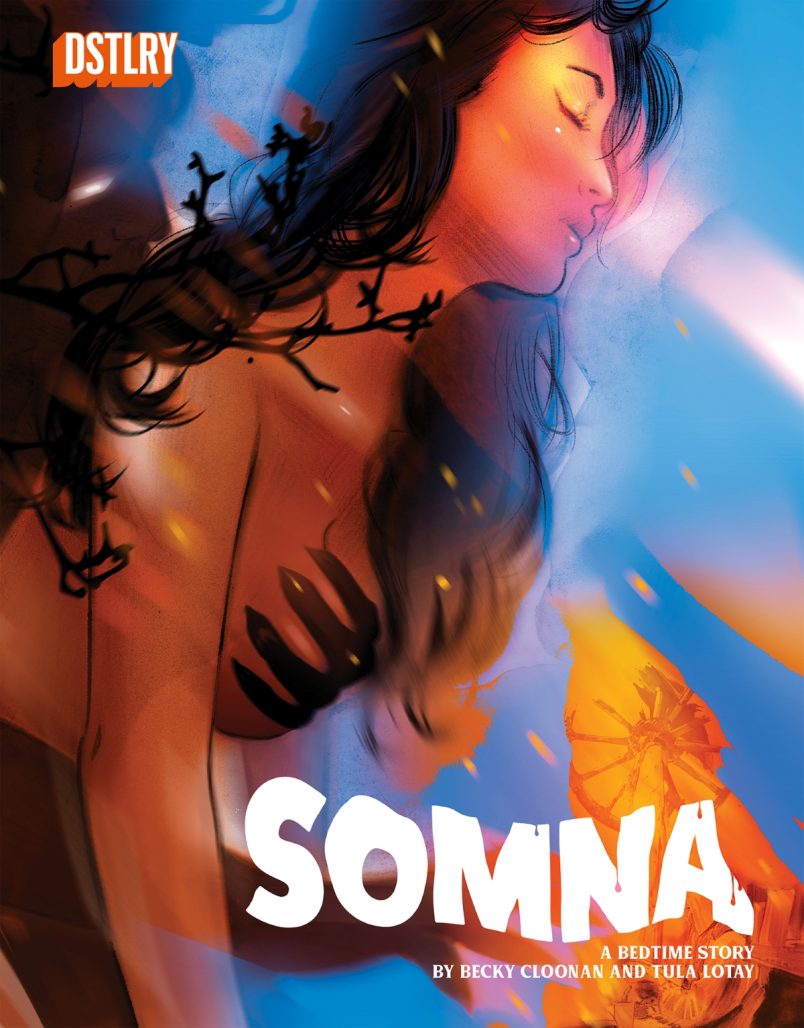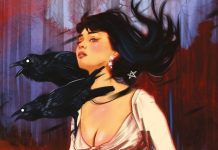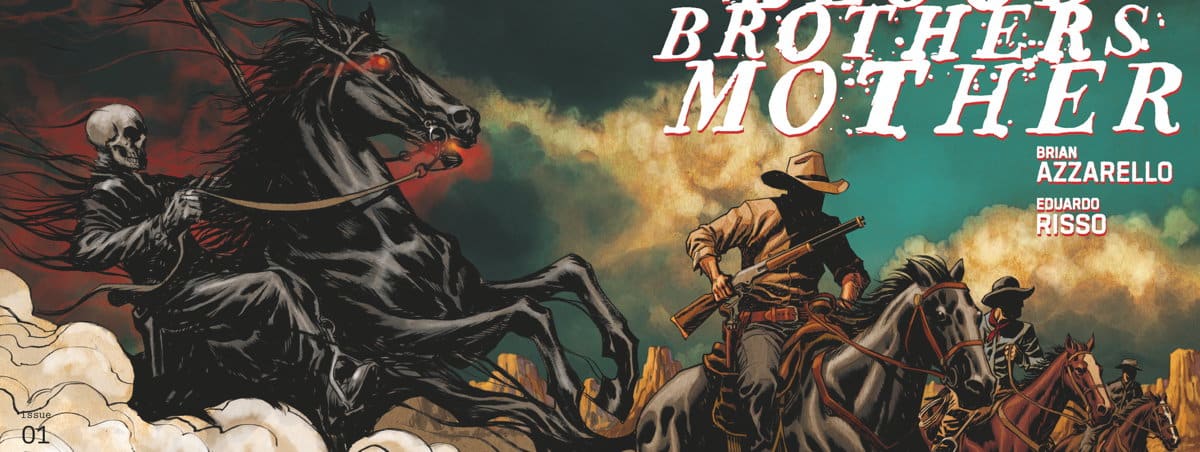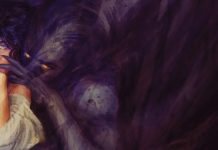by Noam Steinerman
In addition to offering free black-and-white ashcan previews of Gone, written and illustrated by Jock, and Somna, written and illustrated by Becky Cloonan and Tula Lotay, at New York Comic Con, creator-owned publisher DSTLRY brought along several of its creators to the show. In addition to chatting with artist-writer Jock about his current projects, The Beat also caught up with Lotay on Sunday to talk about Somna and DSTLRY.
Check out the interview below, as well as art from Somna #1.
Noam Steinerman: Hope you are enjoying your New York Comic Con 2023! Any highlights?
Tula Lotay: The highlights for shows for me are always seeing my colleagues, people that I work with. I absolutely love that. Last night we had a very big party for DSTLRY like a little mini launch that was absolutely amazing, so that was definitely my highlight. We had cocktails based on all our DSTLRY books and the cocktail for Becky’s and my Somna book was “Safe Hex.” It was a very delicious, very spicy bit of Mezcal and chili powder; that’s my highlight.
Just like being here and seeing all my peers, people that I work with, and people whose work I love. It’s just really nice and everybody’s so kind who comes up to the table. I’m always really overwhelmed by how kind people are and complimentary about my work. So it’s a really nice feeling when I go back home. It invigorates me to want to keep working because I know it’s resonated with some people.
Steinerman: Lots of artists use pen names but most use their real name. Why did you choose to use the pen name Tula Lotay?
Lotay: My real name that everyone uses is Lisa Wood. If you do a Google search for Lisa Wood, you get thousands of artists called Lisa Wood. It’s impossible to have a presence where people find you. So I was saying to my best friend Nabil, I need to make up a name.
I had just watched Romance & Cigarettes by John Turturro and there is a character in that called Tula. I really liked the name Tula. As I sat in the office working with Nabil and said to him, “But what should my second name be?” He swiveled around in the chair and said Tuuulaaa Looootaaay…. And I was like Yes! Tula Lootaaay! That’s basically where it came from and because it is a made-up word I could get Twitter handles and everything.
Steinerman: IGN called DSTLRY “one of the more intriguing comic book publishers to come along in recent years.” What drew you to DSTLRY and how is it different from other comic book publishers?
Lotay: Basically I’m working with people that I greatly admire. The lineup is insane! Such amazing people and DSTLRY is obviously different because the founding creators have a stake in the company. We all want to make it work and we all want to do our own thing and have the people enjoy it.
It resonates with people so it is very, very different. We are all completely invested in every single book that everyone puts out at DSTLRY because it’s like a home and our colleagues are doing this and we love it all. It is a really incredible business model and also I just absolutely adore Chip Zdarsky and David Steinberger. They are amazing. I’ve known Chip for years and I think all the talent they have managed to bring on board with this has blown me away. I can’t quite get my head around being in that lineup. I think sometimes Chip had me tag along because we get along so well.
Steinerman: DSTLRY readers got a taste of what you have been working on in The Devil’s Cut. What can they look forward to in your debut DSTLRY book Somna?
Lotay: Somna is a real labor of love for me and Becky. We are so in love with this book. So we have been talking about it for 10 years. It came about when me and Becky were talking about sleep paralysis because Becky had experienced it. Then, we were talking about Witchfinder General and the movie The Entity.
Becky said, “I would really love to do a story about a shadow man but it gets sexy and spooky.” Because we were both talking about our love of Witchfinder General, we thought it should be set in the world of Witchfinder General, set in a time [the 1600s] where it was just so horrible being a woman and you were just persecuted. You had to be a certain way to fit into society. You were not allowed to experience the normal feelings and desires women would have, so Somna is really all about that.
Women were not allowed back then to be sexual beings since you know no one was in that era. Women were persecuted because of that and the shame comes in when you start experiencing these things. How that manifests itself in this life entity is something we are very, very proud of.
Steinerman: Can you share a bit about how you and Becky are making the book?
Lotay: It is working so perfectly because the idea is based on the woman’s dream state. She’s having dreams or nightmares and it’s the reality that’s going on around her. So I draw the dreams and Becky draws the reality.
As the story goes on and the boundary between dreams and reality merges, Becky and I are going to start mixing the art. So Becky will be inking some of my pencils and I’ll be inking some of her pencils and it will start to kind of get really crazy. It’s working perfectly, and the way we are swapping the art, she wakes or falls asleep. It has just been perfect and a dream. What Becky has done in this book is unbelievable. She pretty much wrote all the dialogue. I am going to go over and do more of her colors to make it look more like my stuff. Her writing is just so incredible. She is amazing and so clever.
Steinerman: What comic books are you currently reading?
Lotay: Books I’ve read recently, because I don’t get much time to read books… I love the Massimo Carnevale Dylan Dog. One of my all-time favorite comics is Domu by Katsuhiro Otomo. I really like This One Summer by Jillian Tamaki: I thought that was beautiful. I’m reading a lot of younger adult stuff with my daughter because she loves it too. Joe Todd-Stanton did this amazing comic book called Bear about a dog named Bear who loses his eyesight. He’s a guide dog but he loses his eyesight and a mean raccoon gets him sent out into the woods where he meets a real bear. That is brilliant. That story is so good. Some of Scott Snyder’s recent work is great. Nice House on the Lake is amazing.
Steinerman: How does dyslexia impact your work?
Lotay: Comics are everything to me because they taught me to read. I was having a lot of trouble in school. Always behind and I couldn’t read or write properly when I left school. This was like in the ’70s, ’80s. I didn’t go to a great school and I was never diagnosed with dyslexia. I was just called stupid and so I couldn’t get through a novel. I can read (I don’t have the kind of dyslexia where words move around on the page with me), it is more not being able to really retain the information without having a visual hook and the b’s and d’s reverse.
So I read novels now. If there is a strong, visual hook then I can get through the book and I’m fine but if there isn’t, it’s hard for me to get into the book. So you’re absolutely right, there is a massive connection between seeing images and visuals. So as a child not being able to read, my dad would buy me comic books and I just absolutely fell in love with this world and it made me want to read. I desperately wanted to know what these characters and amazing pictures were saying. I wanted to know what it was about and it pushed me and I just fell in love with comics.
From that point on, probably about age 7, I liked reading Archie Goodwin, Al Williamson, and Marvel adaptations like Blade Runner, Star Wars Weekly, Judge Anderson, X-Men, Frank Miller’s Daredevil; all of those were my favorites as a kid and still are today. They mean so much to me. Everything I’ve done from that point on throughout my whole life has always been based around comics.
Steinerman: I spoke a moment ago with Aaron Cambell and I asked him what his favorite convention was and he said Thought Bubble. As co-founder, could you tell us a bit more about it?
Lotay: That’s very kind of him. Thought Bubble is based in Leeds in Northern England. It happens every November. I think this year is the 16th year and it’s just such a beautiful show because it is so inclusive and everybody there is just there to have a nice time. You see that at any comic con really, people have a really nice time and are able to express themselves in the way they want. They feel part of something and welcomed, which is lovely.
So Thought Bubble is sort of a smaller version of NYCC. Because it’s smaller you get this wonderful community feel that is so lovely. It only ever deals with artists and writers. There is never any media, so it’s always about the comics and about the people creating comics selling prints of their comics, showing their art. That’s everything it’s about. And being able to inform themselves with panels on how to make comics, how to improve drawing skills, writing skills. There is a big educational aspect of Thought Bubble which the team is doing wonders with. They started creating micro-bursaries to fund writers and artists to help them come to the show and create things. It’s just a lovely, lovely show.
Steinerman: Your fellow DSTLRY creator Scott Snyder said Somna is “super steamy and twisted. It’s great!” It seems like you have a good kinship and when you two work together there is definitely some magic happening. Would you like to work with Scott on any projects at DSTLRY or otherwise in the future?
Lotay: Yes, yes. As soon as Scott wants to work with me again, I’m there! I’ll do whatever he wants. He’s ace. I love him and I love his writing so I kind of hope and pray we will do something together again in the future. A lot of people at this convention have been asking if we will bring Barnstormers back, but we are both very happy with the ending. We would definitely do something new.
Somna #1 will be available in print and digitally on November 22.


